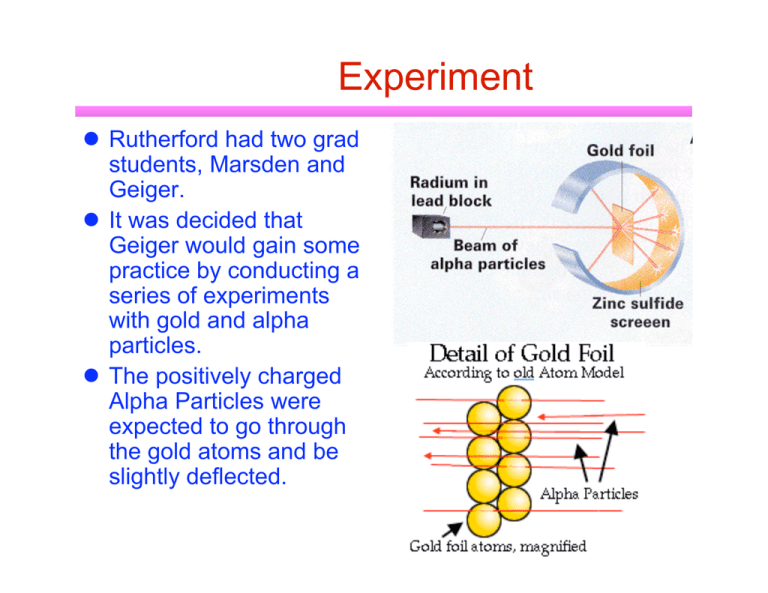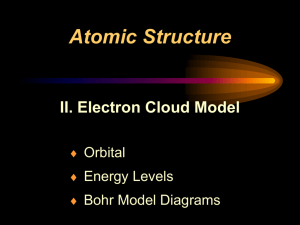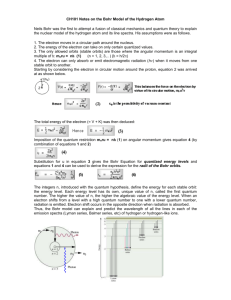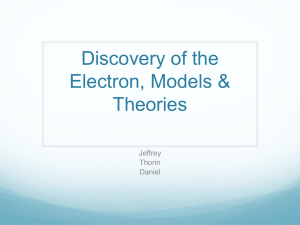Experiment
advertisement

Experiment Rutherford had two grad students, Marsden and Geiger. It was decided that Geiger would gain some practice by conducting a series of experiments with gold and alpha particles. The positively charged Alpha Particles were expected to go through the gold atoms and be slightly deflected. Surprise, surprise, surprise On the screen, marks were only expected to appear in a limited region. Geiger was to explore the places where no results were anticipated. Marsden had to excitedly tell Rutherford that the new student had actually gotten results! Some were almost straight back! Cannonballs and tissue paper Rutherford would later compare it to firing a cannonball at a piece of tissue paper and having the ball bounce back! Rutherford quickly realized that a small, very dense and positively charged nucleus would account for the paths of the alpha particles. It took a lot of geometry and statistics to eventually convince other physicists and to show how big the nucleus was. Solar system model Rutherford model This led to the classic model of the atom- similar to the solar system Distant electrons orbit a massive nucleus due to electrical forces of attraction. Rutherford’s model was very appealing but there were some “minor” problems that had to be solved. What held the nucleus together to be so small? AND… The orbiting electrons were giving off light, due to Conservation of Energy, they should eventually spiral into nucleus! ◆ remember that accelerating charges radiate energy Copyright (c) Grolier Interactive Inc. Another problem with Solar System Model Emission and absorption spectra of gases like hydrogen indicate only certain wavelengths of light are emitted or absorbed by the atoms. Spectra Spectra Continuous spectrum Emission spectrum Absorption spectrum Look at wavelengths of emission spectrum of H2 Consider the 4 wavelengths marked to the right ◆ ◆ ◆ all in visible region of EM spectrum Named the Balmer series after Johann Balmer who found that the wavelengths could be described by a simple empirical equation 1 1 1 = RH( 22 - n2) λ n has integral values of 3,4,5,… and RH is the Rydberg constant ▲ RH=1.0973732X107m-1 Why this pattern? Bohr to the rescue In 1905, Einstein had proposed the wave/particle duality of light with the photon. In 1913, Bohr used the concept in creating a quantum model of the atom. A Niels Bohr interlude Active participant in early development of quantum mechanics and provided much of its philosophical underpinnings ◆ Copenhagen interpretation Bohr headed the Institute for Advanced Studies in Copenhagen, under the support of the Carlsberg brewery Participated in Manhattan project during WWII ◆ play currently on Broadway called Copenhagen deals with Bohr and Heisenberg Bohr’s model of the atom Only certain stable orbits exists for the electrons. While at these orbitals, they do not give off photons. Electrons can only move from orbital to another orbital by gaining or releasing photons (a quanta of energy). ◆ Bohr model Ei-Ef = hf Size of electron orbits is determined by constraints on electron’s orbital angular mometum ◆ mevr =n h n=1,2,3…. Copyright (c) Grolier Interactive Inc. Electron orbits Electrons can only exist in certain allowed orbits n2 h2 rn = m k e2 e e 2 2 2 ◆ ao = h /(meke e ) =0.0529 nm is called the Bohr radius and corresponds to n=1 Energies of orbitals Energies of quantum states given by meke2e4 1 (n2) En = 2h2 13.6 En = - n2 eV n = 1,2,3,… also write 1 1 1 λ = RH (nf2 - ni2) Extension of Bohr model to other atoms Energies of quantum states given by Z2 meke2e4 1 (n2) En = 2h2 Bohr model of the atom was a great success in some areas ◆ ◆ 13.6 Z2 En = - n2 eV n = 1,2,3,… ◆ ◆ explains Balmer and other series predicts a value for the Rydberg constant in agreement with data predicts the energy levels of hydrogen can also be applied to hydrogen-like atoms ▲ ▲ ionized so contains only 1 electron Z protons Arnold Sommerfeld Extended Bohr’s ideas to include possibility of elliptical orbits Thesis advisor to most Europe’s theorists Nomenclature Bohr’s quantization of angular momentum led to principal quantum number n In Sommerfeld’s model, also have orbital quantum number l ◆ l goes from 0 to n-1 ▲ ▲ so n=1 only has l=0 n=2 has l=0,1 electron in nth orbital can move in any of the l suborbitals All states with same principal quantum number n are said to form a shell ◆ states with given values of n and l are said to form a subshell ◆ Not another quantum number Yes, another quantum number It was discovered that the spectral lines of a gas are split into several closely spaced lines when the gas is placed in a strong magnetic field ◆ Zeeman effect Energy of an electron is slightly modified when it’s in a magnetic field ◆ ◆ Introduce new quantum number ml, the orbital magnetic quantum number ml is restricted to integer values from -l to +l Complete nomenclature Enter de Broglie again Bohr’s model worked but it lacked a satisfactory reason why. De Broglie suggested that all particles have a wave nature. ◆ λ=h/p It was the Wave Nature of the electron that determined the nature of the orbits.






